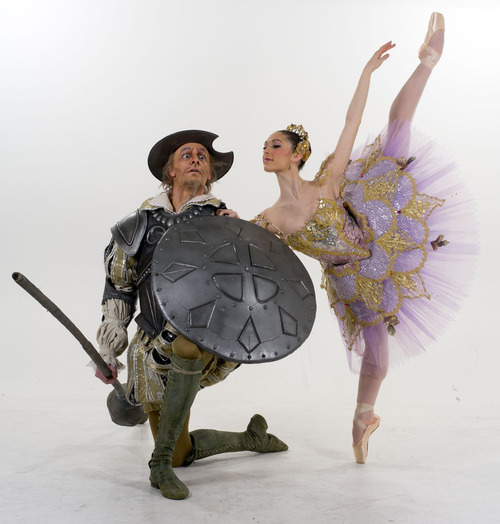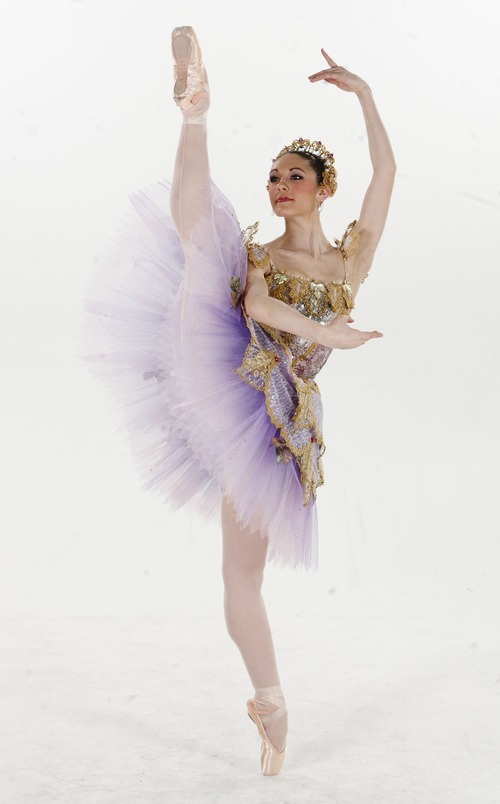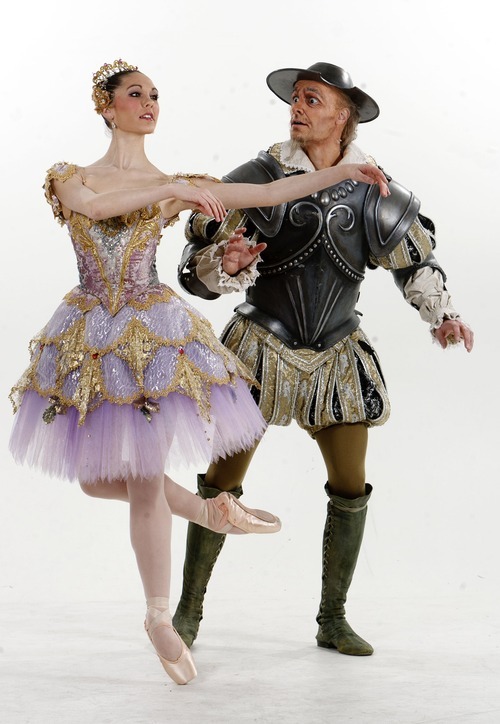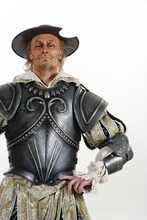This is an archived article that was published on sltrib.com in 2012, and information in the article may be outdated. It is provided only for personal research purposes and may not be reprinted.
Ballet megastar Anna-Marie Holmes was in Salt Lake City last week to stage one of the hallmarks of classical ballet, "Don Quixote," for Ballet West. In 1962, Holmes became the first ballerina from the West to jeté past the Iron Curtain and dance with the Kirov Ballet. "All great ballet companies should have a 'Swan Lake,' a 'Sleeping Beauty,' a 'Giselle' and a 'Don Q,' " Holmes insists.
There are many adaptations of Miguel de Cervantes' classic novel; this season alone, at least seven major companies are performing the ballet, each adapted by different choreographers. All take liberally from the original choreography by Marius Petipa, first performed in 1869 by the Ballet of the Imperial Bolshoi Theatre of Moscow to the music of Ludwig Minkus.
Ballet West artistic director Adam Sklute labels the ballet "entertaining and vibrant." "This production has everything — romance, humor, brilliant dancing, lavish sets and costumes, and a lively score," he says.
The valiant and eccentric Don Quixote and his comic sidekick-squire, Sancho Panza, lead the well-known cast of characters from Cervantes' novel — Lorenzo, Gamache, Kitri and Basilio — through the classic ballet love story. The father (Lorenzo) chooses a wealthy suitor for his daughter (Kitri) to marry, but she is in love with the poor, handsome town barber (Basilio). The high-speed romp includes jousting with windmills and ends with the knight errant continuing on his deluded yet romantic quest for the elusive Dulcinea.
"It is interesting to note that all of today's 'Don Q's' are created or staged by Russians, with the exception of Anna-Marie, who is responsible for many ballets coming to the West," Sklute said.
Holmes' unusual connection to Russia began in 1961. She and her then-husband, David, were rising stars at Canada's Royal Winnipeg Ballet when the first guest artists out of Russia arrived.
"These dancers were from St. Petersburg, which was Leningrad then, and I'd had Russian teachers," Holmes said. "They told me they noticed I had a slightly Soviet style and asked if I'd want to come and perfect it. Knowing no one had ever been invited to the Kirov, I said, 'Of course.' "
After not hearing back from the Russians for a year, she accepted a personal invitation from Agnes de Mille to dance in "Brigadoon" with Edward Villella on Broadway.
"One day in 1962, I got a cable saying 'Your visas are waiting for you in Ottawa.' When David and I got to Ottawa, they asked us if we wanted to go to Leningrad or Moscow, and of course we chose Leningrad, since no dancer had ever gone there," Holmes said.
When they arrived, their choice seemed a mistake, and they were immediately called into then-Kirov artistic director Konstantin Sergeyev's office. They were told through an interpreter that the Kirov didn't accept guests and it must have been the Bolshoi in Moscow that accepted them. Holmes said her eyes welled up and she began to cry.
"He then telephoned some other official at the Ministry of Culture and after a long, heated discussion in Russian that of course we didn't understand, he hung up and cheerfully welcomed us to the Kirov," she said.
After that, their time was magical. Holmes and her husband received daily private lessons from Kirov luminaries Natalia Dudinskaya and Aleksandr Pushkin, whose other famous pupils include Rudolf Nureyev and Mikhail Baryshnikov.
The couple debuted as principal dancers in "Flames of Paris" and were allowed to attend the "teacher course," which provided special insight into the choreography of all the classics and gave them access to the musical orchestrations. But in 1963, when the couple were offered a 10-year contract, they declined, wanting to take advantage of opportunities to guest with companies around the world.
Holmes loved the repertoire she had learned and was reluctant to leave it behind. The couple brought famous ballets such as "La Bayadère" and "Le Corsaire" out of Russia to the West. Nureyev had defected the year before the Holmeses arrived, and no one in Russia was even allowed to mention his name. Once back in the West, Holmes gave Nureyev the materials he needed to reconstruct his version of "Don Q."
"I could tell where the tapes broke when I saw Nureyev's version onstage because he started doing a bunch of little rond de jambes to fill in," she joked.
The Holmeses brought their knowledge to the rest of the world as well. For example, they worked in upstate New York with Bronislava Nijinska in 1968 and with the National Ballet of Holland from 1969-72, and toured the United States with Ruth Page's National Ballet, which included Salt Lake City performances in 1971. In addition, they performed as guest artists with National Ballet of Cuba in Havana, American Ballet Theatre, and Dance Theatre of Harlem.
Their daughter, Lian, was born in Chicago in 1978; the couple later separated. But Holmes' career as a teacher and coach was just beginning.
Bruce Marks, who became the artistic director of Boston Ballet after seven years leading Ballet West, asked her to direct the faculty for the Boston Ballet School's summer school in 1985, and she later became his assistant artistic director.
Holmes' Russian connections served the company well when in 1987 she brought Dudinskaya to coach the Boston company in its production of "Giselle." Also notable was her arranging in 1991 for Dudinskaya and Sergeyev to come to Boston to stage a Russian-style, large-scale "Swan Lake," which evolved into a Russian-American collaboration including dancers, scenery and other cultural exchanges.
Now, at 69, Holmes' boundless energy and exuberance are infectious. She credits her daughter with the theatrical elements she has introduced into her version of "Don Q," making it a particularly entertaining ballet.
Holmes is proud of Lian, now 34, a graduate of Wellesley College with a master's from Trinity Repertory Theater and professional experience in music, theater and film. Lian Holmes is a tenure-track professor at Bennett College in Greensboro, N.C., with wedding plans this May.
"Looking back, the 'Don Q' I did at first was the verbatim Kirov version, but then I decided it needed more Spanish flavor," Holmes said. "So I added a fan dance, a flamenco clapping dance for the men, but then it was too much. So then I cut it down and left in the best parts."
Holmes described the culture at Ballet West as particularly warm and friendly while remaining competitive. The relationship among dancers, and between dancers and staff, is familial, and she said she doesn't often see this kind of mutual respect. And after working in six countries and most of the United States just this year, she should know.
facebook.com/nowsaltlake —
Tilting at windmills
Ballet West presents "Don Quixote," a ballet adapted from Miguel de Cervantes' epic novel, set to music by Ludwig Minkus. This version is adapted from Marius Petipa's 1869 original, with choreography by Anna-Marie Holmes, the first American dancer to train and dance in Soviet Russia.
When • Opens Friday, Feb. 10, at 7:30 p.m.; continues Feb. 11 and 14-18 at 7:30 p.m., with a 2 p.m. matinee Feb. 18.
Where • Capitol Theatre, 50 W. 200 South, Salt Lake City
Tickets • $19-$75 (plus handling fees) at http://www.arttix.org or 801-355-ARTS. Group discounts available at 801-869-6900.
Also • The ballet will be accompanied by the Utah Chamber Orchestra, conducted by Terence Kern on Feb. 10, 11 and 18; Jerry Steichen, principal pops conductor for the Utah Symphony, will conduct Feb. 14-17.
More • Ticketholders are invited to Warmup Q-and-A conversations with Ballet West artistic staff an hour before the performance.
And even more • For another artistic take on the Don Quixote story, Pioneer Theatre Company will present the musical "Man of La Mancha" May 4-19. For information or tickets, call 801-581-6961.











